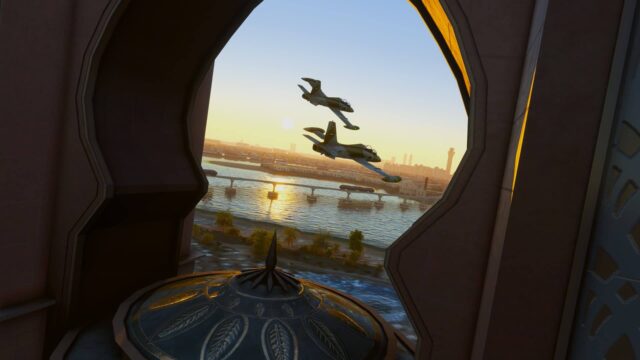
Aerosoft’s Munich X is a very detailed depiction of the Franz Josef Strauss airport in Munich Germany. The airport has been thoroughly and meticulously recreated using high resolution photo real ground textures along with intricately detailed structures and objects. To cap it off they have also populated the entire area with dynamic vehicle traffic. The airport originally opened in 1992 and has two runways; 08L/26L and 08R/26R both at 4000 meters or 13,123 feet long. Since it’s opening it has grown to become the second busiest airport in Germany in terms of passenger traffic.
Installation
The installation uses the all too familiar Aerosoft installer. After having installed add-ons from many different vendors I consider Aerosoft’s to be one of the best. If you are a first time buyer you will soon see that it is very easy to use. During the installation you will be required to provide your registration information and confirm the FSX program path. Additionally you are also given a choice to install static aircraft. My suggestion if you have a 3rd party AI aircraft program is to not select this option. This is a very busy airport so in all likelihood most parking spots will end up being occupied anyway. As the final step the program adds the scenery to the FSX scenery library. The next time you open up your programs menu, you will see a group titled Aerosoft and within it Mega Airport Munich X. From here you have easy access to the following: Charts, EDDMTraffic, Manual and Season-Tool.
This product is available for both FSX and FS2004, my review is based on the FSX version of this product.
Configuration
There really is no configuration needed however as part of the package you get a Traffic tool and Season tool. Both of these are really self explanatory. The traffic tool allows you to activate or deactivate traffic options for various locations in the scenery.


The season tool lets you match the scenery vegetation to the one of your choosing which for best results should normally be the same as the season currently selected in FSX.
Documentation
This scenery comes with two PDF documents; a German/English product manual and a Charts manual.
The manual contains the customary information provided with Aerosoft releases; system requirements, brief write ups on the installation and removal of the scenery and a little bit of airport history with some technical specs such as frequencies. Additionally, there are sections titled Appendix and Performance in FSX; there is some interesting reading here as they provide you with their recommendations for scenery settings and explain a bit about other issues that may affect scenery performance. Again, as I do with every other product I have reviewed it is my opinion that you should take a few minutes to read the manual. It may end up providing you with the answers as to why the scenery is behaving in that certain way that you weren’t expecting.
With regards to charts I was pleasantly surprised by their decision to include them. The trend seems to be that you get the source URL and from there you have to create some sort of account to be able to access and then download any charts you may want. The charts they’ve provided are extensive and include everything you will need regardless of the type of flying you do. Most are dated either late 2009 or 2010.
Scenery
The screenshots comparing the FSX default rendition of Munich airport with the Aerosoft version show how barren the FSX version looks in contrast.


Structures
This was a very interesting airport to explore. Overall the buildings have been recreated in meticulous detail. One thing about Munich airport that stood out was the architecture here, most buildings are aesthetically pleasing and they tend to not be square boxes. The Munich Airport Center or MAC is the most prominent structure and the focal point in my opinion. The convex tent like roof with external supports stands out above all other buildings. It’s unique character has been recreated down to the geometric patterned interior floor. If you take the time to go inside you can check out which stores and restaurants are found here.
Their dedication to detail doesn’t stop with the MAC by any means; exploring the rest of the airport many other examples of their fine work can easily be seen. The Lufthansa hanger with it’s unique externally supported roof or the complicated design of the visitor’s center or the glassed in tube pedestrian walkway that goes to the Munich rail line terminal on the airport grounds. There is so much to see here and all of it is worth checking out.
I will point out one last structure which really isn’t a building per say but I felt deserved to be mentioned. It is the Visitor’s Center viewing hill; it gives visitors and sight-seers a good vantage point where they can look out towards the western aircraft apron and the terminal 1 building.








Roads
The other major element that makes this scenery special is the multi dimensional network of roads. To have modelled this as extensively as they have is quite a feat.  What made it stand out? It was the overall look and attention to detail that made it so convincing.  Although the 3 dimensional affect could be seen throughout the entire airport it was especially noticeable near the taxiway bridges and runways because it is at these locations you get up close and the affect is quite amazing and realistic. As you leave the aprons and taxi to either runway you will eventually have to make your way across one of these bridges and with all of the road traffic going on it is inevitable that you will see some going by underneath. I don’t recall seeing such an array of overpasses, underpasses and ramps in any other airport scenery. Everything looks authentic right down to the road signs. It is worth taking the time to fly or drive around the airport just to see all the work they’ve put into this aspect of the scenery.




You can’t have a complex array of roads like this without traffic so to keep it as real as possible they’ve done another wonderful job here and populated them with a variety of cars, trucks and buses. It was very interesting to watch the traffic navigate the entire system of roads.
Traffic was not restricted to those roads I just described but was also present within the hanger lines and apron areas. The difference here was that the vehicle types were push back tugs, fire fighting trucks, security vans, cargo tractors, passenger buses and a variety of other service vehicles.
As an added touch of realism the Munich Suburban railway line which connects the airport to the city of Munich has been modelled. The railway line which happens to run parallel to the Munich Airport access road is there and like most other features contains some impressive detailing. Looking closely you can see that they’ve even included the power lines that run over top the tracks. The train is animated and runs along the route at regular intervals.
This is already a busy place so when you add AI aircraft to the mix it is easy to get a sense of how hectic it can get. I use Ultimate traffic 2 and as you can tell in the screenshots there was never any shortage of aircraft activity. I’d like to state that even with all of the AI traffic, frame rates remained very good.
Objects
With everything going on it is easy to lose sight of all the little bits and pieces that go into making an airport everything it needs to be. It’s all of these objects that add those finishing touches to the product. I am talking about items such as the overhead lighting around the apron and parking areas, the approach and PAPI lighting systems, blast walls and safety barriers, perimeter fencing, wind socks, cargo containers, safety pylons, runway/taxiway markers and so much more. Nothing seemed to be lacking as far as I could tell.




Ground textures
The ground textures used are of a high resolution and that gives a very crisp and clean look even when you are very close. The detailing is obvious especially on the hard surfaces. The directional and informational markings look very realistic. There are also subtle differences in the colour of the concrete that give an impression of weathering. Dirt and rubber stains are also evident in places that you’d expect to see them, areas such as runway touch down zones and parking areas.



AGNIS Docking system
For an extra touch of realism and to assist in parking your aircraft they’ve modelled the AGNIS (Azimuth Guidance for Nose-In Stand) docking system which is one of the most popular systems in use. It consists of a visual light system that assists the pilot in manoeuvring to a precise location. It worked very well each time recognizing the aircraft type and providing correct information to guide me to the exact parking spot. I tried this at different parking locations and with several different aircraft types and never had a problem.


Night time
An airport as busy as Munich never seems to have any quiet times so night flying is a very normal part of the day to day cycle of activity. The night time rendering of the airport was very well done which was really no big surprise. Intensity levels and coverage areas of the exterior lighting were all well done. For the buildings they stayed away from having all the windows brightly lit opting instead to having some areas lit up and others remaining dark. This gives a much more realistic appearance.





The only real negative I could come up with was that the scenery doesn’t blend well with the surrounding countryside. The scenery does not include any enhancements to the nearby geographic area so even from a long way off it stands out quite noticeably.
Final Thoughts
Aerosoft has released another winner with Munich. The immersive atmosphere at this airport is one of the best I have seen. Despite all of the airport activity and the exceptional amount of detailing the impact on performance was minimal and I was very happy with how it performed. If you are looking for a large airport that doesn’t drag your PC to it’s knees then this is one for you.
I flew a number of different approach and departure routes with the EMB145, MD81 and Boeing 757 and didn’t encounter any problems.
My Ratings
- Installer: Excellent. Simple to use.
- Documentation: Good manual. Full set of charts included.
- Modelling: Excellent.
- Extras: AES Lite provides road and apron traffic. Traffic and season tools included.
- Download Size: FSX 213Mb, FS2004 258Mb
- Price: EUR 20.97 + VAT where applicable
- Purchase link: http://secure.simmarket.com/aerosoft-online-mega-airport-munich.phtml
Test System:Â Intel i7 920 OC @ 3.9 Ghz, 6 Gb RAM, EVGA 285 GTX w/1Gb video, Win 7 Ultimate 64, FSX w/acceleration, Ultimate traffic 2, REX overdrive, UTX Europe, AES 2.08
Richard Desjardins












